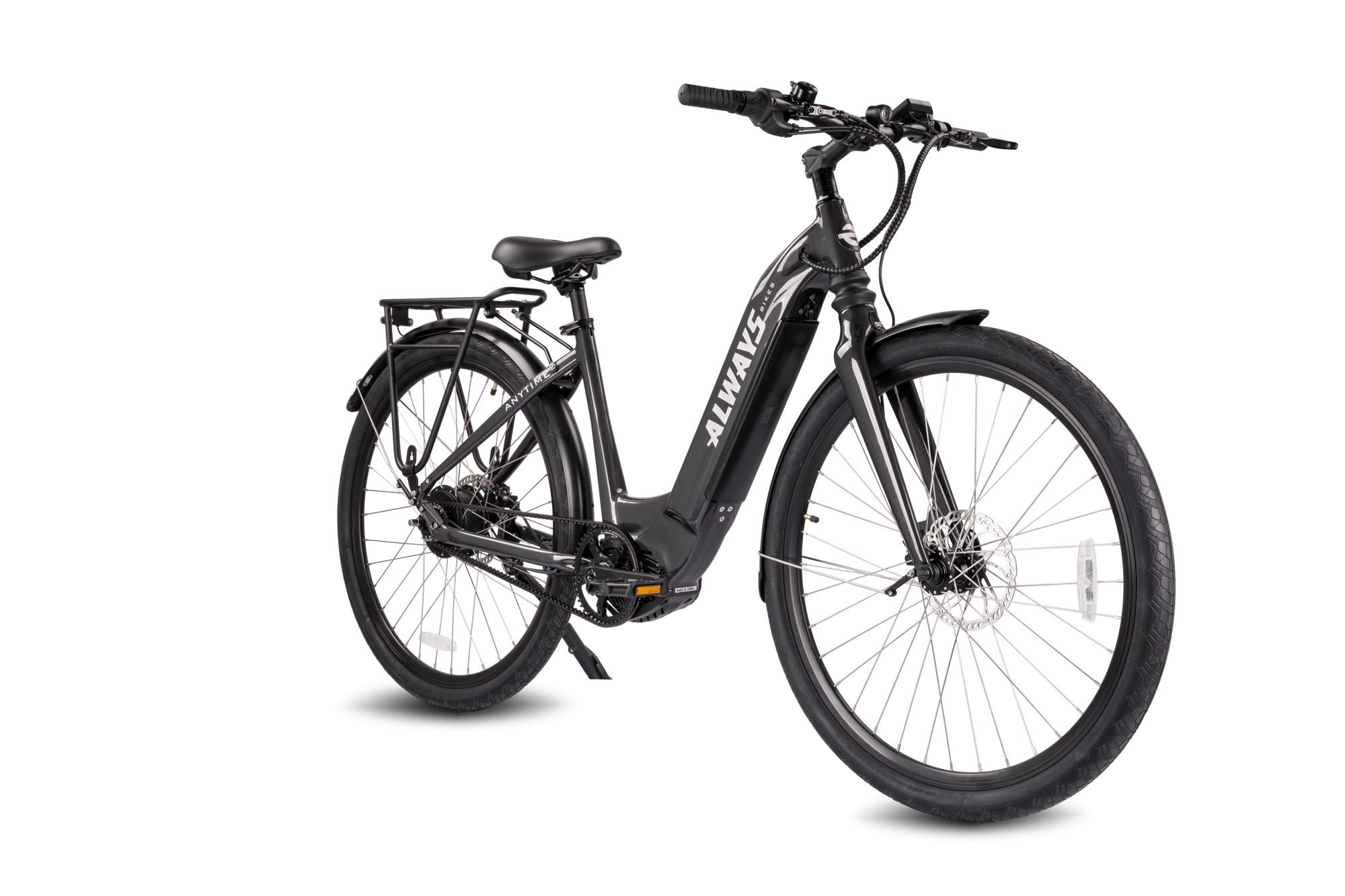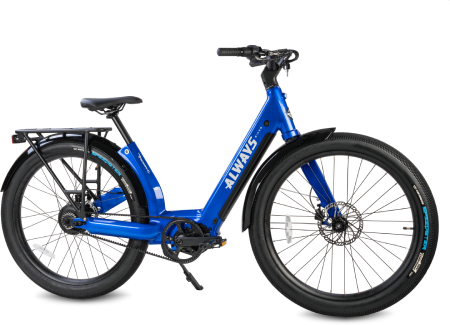YOUR E-BIKE BUYERS GUIDE
KEY THINGS TO CONSIDER WHEN CHOOSING YOUR IDEAL E-BIKE
1. Know Your Ride: Why Riding Style Matters
Deciding your riding style is the first step to unlocking the perfect e-bike experience. Just like picking the right shoes for an activity, selecting an e-bike that aligns with how you plan to ride ensures enhanced comfort and optimal performance.
Here are some key questions to ask yourself when deciding on your preferred riding style:
- Where will you be riding most often?
- Are you looking for a workout with some electric assist, or a more relaxed cruising experience?
- Do you prioritize speed, comfort, cargo capacity, or a combination?
The Three Major E-bike Categories

CITY AND COMMUTING E-BIKES
Experience the joy of effortless commuting and fitness with a city and commuting e-bike. Its powerful motor, comfortable riding position, and versatile performance make it an ideal choice for urban adventurers and fitness enthusiasts alike.

CARGO E-BIKES
Revolutionize your errands, commutes, and adventures. Cargo e-bikes, with their muscular frames and spacious platforms, are the ultimate utility vehicles on two wheels. Effortlessly hauling groceries, transporting tools, or even taking your kids on an adventure, all thanks to the powerful electric motor that takes the sting out of hills and long distances.

MOUNTAIN E-BIKES
Conquer rugged trails and explore hidden wilderness with the mountain e-bike, your trusty companion for off-road adventures. Its powerful motor, durable construction, and advanced suspension system empower you to tackle challenging terrain with confidence and control.
2. Spend Savvy: Be Budget Conscious
While the thrill of cruising on an e-bike is undeniable, it's crucial to consider your budget before embarking on your e-bike journey. Here's why:
- Matching Features to Needs: E-bikes come with a range of features, from basic to high-tech. A realistic budget ensures you prioritize the features most important for your riding style without overspending on unnecessary bells and whistles.
- Long-Term Investment: E-bikes are a significant investment. Setting a budget helps you find a quality e-bike that fits your current financial situation while considering potential maintenance and upgrades in the future.
- Peace of Mind: Explore all the e-bike features so you know exactly what you're getting. That way, you won't be surprised later by a missing feature you actually need, and your e-bike adventures will be filled with happy trails, not frustration.
3. Essential E-bike Features Every Rider Should Consider
Motor power is key to conquering hills and accelerating smoothly. Higher wattages (750W) make tackling steeper inclines a breeze, while lower wattages (around 250W) are perfect for cruising flat terrain. Consider weight too: You will need at least 280 watts to get 200lbs up an average hill at 10 mph, and it jumps to 350 watts if you add 50lbs (like a child or groceries).
For a balanced ride, mid-drive motors distribute weight evenly across the e-bike, enhancing handling and balance. This might be ideal for riders who prioritize maneuverability (think mountain e-bikes). Meanwhile, rear hub motors offer a budget-friendly alternative, but some riders might perceive them as less stable.
E-bike range is measured in watt-hours (Wh) and reflects the total distance achievable with a full battery. To ensure you're not left stranded mid-adventure, consider these range-influencing factors: battery capacity (higher Wh equals longer range), weight (carrying more passengers or cargo reduces range), and desired riding speed (higher speeds drain the battery faster). Consider the ALWAYS Anytime; the 672 Wh battery will take a load of 165lb 35-50 miles on paved road at max throttle.
A reliable braking system is essential for safe e-bike riding, especially with increased weight and potential for higher speeds. Prioritize a system that delivers confident stopping power. Hydraulic disc brakes are the gold standard for e-bikes, offering superior control and shorter stopping distances compared to traditional rim brakes. A 200-pound rider going 20 mph on rim brakes might need 15-30 feet to stop, while hydraulic disc brakes can significantly reduce that distance to 5-20 feet depending on terrain.
Several additional features can elevate your e-bike experience and cater to specific needs. Look for e-bikes equipped with:
- Integrated self-powered lights work just like a car – you have light when you need it. No charging required or forgetting to put them on the bike in the first place.
- Fenders to keep you clean and dry during wet rides.
- Security features for peace of mind.
4. Ride Confidently: Mastering E-Bike Safety
E-bikes offer a thrilling and convenient way to explore the world, but safety should always be your top priority. Make sure to consider these tips before hitting the road:
- Helmet: Always wear a properly fitted helmet that meets safety standards. This is the single most important safety measure.
- Visibility Matters: Equip yourself with reflective clothing, especially during low-light conditions. Equipping your e-bike with a headlight and taillight is essential for safety, particularly in low light conditions such as gloomy days or dusk.
- Signal Your Intentions: Use hand signals to indicate turns and stops, just like cyclists do. This helps other road users anticipate your movements.
- Ride Defensively: Assume other drivers may not see you and be prepared to react defensively. Maintain a safe distance from cars and avoid weaving in and out of traffic. This is when good brakes and agile bike handling are really important.
- Obey Traffic Laws: Stop at red lights and stop signs, and yield the right of way to pedestrians and other vehicles as required by law.
5. Ride Smart: E-Bike Regulations
E-bike regulations vary significantly across the United States. Understanding these differences can ensure you're riding legally and safely. Here's a breakdown of some key regulatory categories to consider:
-
Classification: States classify e-bikes differently, such as bicycles, mopeds, or even motor vehicles. This classification impacts regulations regarding:
- Speed limits: E-bikes classified as bicycles typically adhere to standard bicycle speed limits, while mopeds or motor vehicles might have higher limits.
- Registration and licensing: Some states require registration and licensing for certain e-bike classes, similar to mopeds or motorcycles.
-
Power and Speed: Many states regulate e-bikes based on motor wattage and maximum speed. For example, a common classification is for e-bikes with motors under 750 watts and a maximum assisted speed of 20 mph to be treated as bicycles with minimal regulations.

|

|

|
|
|---|---|---|---|
| Class 1 | Class 2 | Class 3 | |
| Pedal Assist |
|
|
|
| Throttle |
|
|
|
| Max Speed |
20 mph
|
20 mph
|
28 mph
|
6. Basic Maintenance Tips To Stay On The Road
Regular e-bike maintenance is crucial for safety. Before every ride, inspect your brakes, tires, and lights. Ensure your tires are properly inflated and that your brakes are functioning correctly. Follow the manufacturer's instructions for charging your e-bike battery to maintain its lifespan and safety.
Always refer to your e-bike's owner's manual for specific maintenance recommendations and service intervals. For more complex tasks like internal gear hub adjustments or motor maintenance, it's best to consult a qualified e-bike mechanic to ensure proper care and avoid damaging your e-bike.
By following these basic maintenance tips, you can keep your e-bike running smoothly and safely, extending its lifespan and maximizing your enjoyment of this exciting mode of transportation.


.png?width=2000&name=DSC00695%20(1).png)


